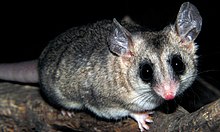Thylamys
| Thylamys[1] | |
|---|---|

| |
| Elegant fat-tailed mouse opossum | |
| Scientific classification | |
| Domain: | Eukaryota |
| Kingdom: | Animalia |
| Phylum: | Chordata |
| Class: | Mammalia |
| Infraclass: | Marsupialia |
| Order: | Didelphimorphia |
| Family: | Didelphidae |
| Subfamily: | Didelphinae |
| Tribe: | Thylamyini |
| Genus: | Thylamys Gray, 1843 |
| Type species | |
| Didelphis elegans Waterhouse 1839
| |
| Species | |
|
See text | |
Thylamys is a genus of opossums in the family Didelphidae. The premaxillae are rounded rather than pointed. The females lack a pouch. The females' nipples are arranged in two symmetrical rows on the abdomen.[2] All species but T. macrurus store fat in their tails.,[3] although this is not necessarily true for all species in the genus.[4] Fossils belonging to the genus date back to the Miocene, with the oldest specimens being found in the Cerro Azul Formation of Argentina and the Honda Group of Colombia.[5] Genetic studies indicate that the genus may have originated around 14 million years ago.[6]
Taxonomy
Cladogram of living Thylamys species.[7][8]
| |||||||||||||||||||||||||||||||||||||||||||||||||||||||||||||||||||
Other species of Thylamys.[11]
- †T. colombianus Goin 1997
- T. fenestrae (Marelli 1932) [12]
- †T. minutus Goin 1997
- †T. pinei Goin, Montalvo & Visconti 2000
- †T. zettii Goin 1997
References
- ^ Gardner, A.L. (2005). "Order Didelphimorphia". In Wilson, D.E.; Reeder, D.M (eds.). Mammal Species of the World: A Taxonomic and Geographic Reference (3rd ed.). Johns Hopkins University Press. pp. 17–18. ISBN 978-0-8018-8221-0. OCLC 62265494.
- ^ Eisenberg, John Frederick; Redford, Kent Hubbard (1999). Mammals of the Neotropics: The Central Neotropics: Ecuador, Peru, Bolivia, Brazil. University of Chicago Press. p. 624. ISBN 978-0-226-19542-1.
- ^ Gardner, Alfred L. (2008). Mammals of South America: Marsupials, xenarthrans, shrews, and bats. University of Chicago Press. p. 669. ISBN 978-0-226-28240-4.
- ^ Voss, R.S. & Jansa, S.A. (2003). "Nonmolecular data and new IRBP sequences: separate and combined analyses of didelphine relationships with denser taxon sampling". Bulletin of the American Museum of Natural History. 276: 1–82. doi:10.1206/0003-0090(2003)276<0001:PSODMI>2.0.CO;2. hdl:2246/444. S2CID 55193165.
- ^ Braun, J.K.; et al. (2005). "Phylogenetic and biogeographic relationships of mouse opossums Thylamys (Didelphimorphia, Didelphidae) in southern South America". Journal of Mammalogy. 86 (1): 147–159. doi:10.1644/1545-1542(2005)086<0147:PABROM>2.0.CO;2.
- ^ Steiner, C.; et al. (2005). "New DNA data from transthyretin nuclear intron suggest an Oligocene to Miocene diversification of living South American opossums (Marsupialia: Didelphidae)". Molecular Phylogenetics and Evolution. 35 (2): 363–379. doi:10.1016/j.ympev.2004.12.013. PMID 15804409.
- ^ Upham, Nathan S.; Esselstyn, Jacob A.; Jetz, Walter (2019). "Inferring the mammal tree: Species-level sets of phylogenies for questions in ecology, evolution and conservation". PLOS Biol. 17 (12): e3000494. doi:10.1371/journal.pbio.3000494. PMC 6892540. PMID 31800571.
- ^ Amador, Lucila I.; Giannini, Norberto P. (2016). "Phylogeny and evolution of body mass in didelphid marsupials (Marsupialia: Didelphimorphia: Didelphidae)". Organisms Diversity & Evolution. 16 (3): 641–657. doi:10.1007/s13127-015-0259-x. S2CID 17393886.
- ^ Flores, D.; Teta, P. (2016). "Thylamys citellus". IUCN Red List of Threatened Species. 2016: e.T199835A22172943. doi:10.2305/IUCN.UK.2016-2.RLTS.T199835A22172943.en. Retrieved 9 January 2020.
- ^ Flores, D.; Teta, P. (2016). "Thylamys pulchellus". IUCN Red List of Threatened Species. 2016: e.T199834A22172571. doi:10.2305/IUCN.UK.2016-2.RLTS.T199834A22172571.en. Retrieved 9 January 2020.
- ^ Thylamys at Fossilworks.org
- ^ Martin, G.M.; Flores, D. (2016). "Thylamys fenestrae". IUCN Red List of Threatened Species. 2016: e.T199836A22172852. doi:10.2305/IUCN.UK.2016-2.RLTS.T199836A22172852.en. Retrieved 9 January 2020.
